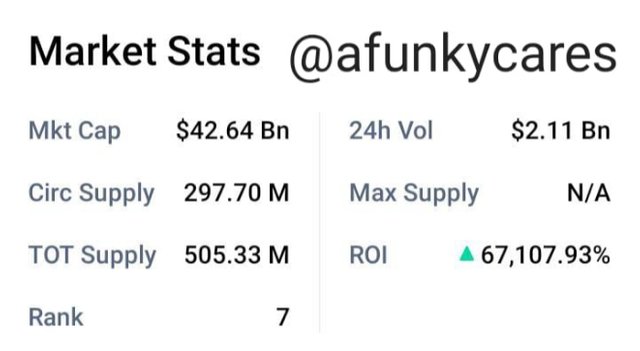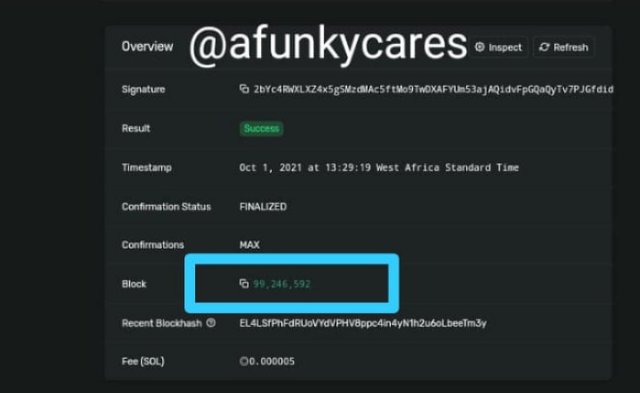Solana Blockchain - Crypto Academy / S4W4 - Homework post for pelon53
Hello Professor @pelon53 and my fellow steemians. I have learnt so much from this course presented by our great professor. I would take out this time to attempt the course in the best of my knowledge. I hope my write up makes sense to every reader who comes across it.
In this task, I shall briefly talk on the Solana blockchain before I go on to talk about what the task is required of me.
SOLANA BLOCKCHAIN
The Solana Blockchain released in April 2019 was developed by a group of developers in Solana Labs and Solana Foundation. Though Solana is popularly known with Anatoly Yakovenko, the other members of the team of its developers are Alevtina Yakovenko and Batts Masterson.
Solana is an open-source and decentralized blockchain which achieved consensus by making use of two type of
algorithm - Proof of stake and Proof of History. The native token of this blockchain is SOL.
Solana also interact with Smart Contracts and does the Ethereum blockchain. It has a very scalable network, and can perform thousands of transactions in a second at a very low cost compared to Ethereum. This makes it a long-term competitor of the Ethereum blockchain.
Question 1.- Explain in detail the PoH of Solana.
Solana is the largest, fastest and most
cost effective decentralized application blockchain platform presently in the world today.
It adopts both the Proof of Stake (PoS) and Proof f History consensus algorithm which makes it environmentally friendly just like it major competitor Ethereum and the popular Bitcoin.
PoS involves staking something to be able to validate transactions in a decentralized network. This is done in order not to give the power to validate to just a set of persons who have upper hand. On the Solana blockchain, validators stake SOL in order to be able to validate transactions. The consumption of power in the operations transaction validators is far less when compared to other blockchains.
Validators of transactions who work on the network are rewarded with SOL. End users of the SOL tokens can earn rewards by staking their SOL to validators who will hand over to them the reward from the stake.
SOLANA PROOF OF HISTORY (PoH)
source
Decentralized systems have the problem of standing together on time. Every decentralized system therefore developed a way for the network on the time each transaction occurs in order for orderliness. This they did by adopting a centralized timing solution for their network. Example is the synchronized atomic clock used by Google Spanner.
The problem of assigning time to transactions in blockchains is more difficult because nodes in blockchains find it extremely difficult to trust a source of time that comes from outside their network or the timestamp with which a message is sent.
Many blockchains uses Hashgraph to solve the problem of time by assigning a medium timestamp. This is done by the a supermajority of the network. Therefore, every message that comes into the system goes to supermajority of the network's nodes to get validation until enough validation is gotten by each message. This way of agreeing on time is a kind of slow.
Proof of History is the mechanism used by the Solana Blockchain to make the nodes in the network agree on the time a transaction took place for to attain uniformity.
Instead of going by the way of other blockchain networks, the Solana Proof of History found a way of trusting the timestamp on every message or transaction by developing a historical record proving a transaction occurred at a specified time. This mechanism is called the verifiable delay function. Verifiable Delay Function provides a way of making the whole network agree on the time a transaction occurred. PoH uses a mechanism of automatically assigning time or should I say accepting the time in a transaction by a node that is connected to other nodes which makes it the whole network agree on time so the transaction can quickly be verified and completed.
Technically, the Hash function SHA25 is used to hash the events and transactions done on the Solana blockchain. Using this function, it takes in an input and manufactures an uncommon output that is hard for anyone to guess. This output is taken and used for the transaction of the following hash. This order of transactions is now built into the output that has been hashed.
An unbroken chain of transactions is now created by this hashing process. This creates an order of transactions that can be clearly and easily verified by automatically adding a validator to a block without the need for timestamp. Ordering transactions in a of hashes by helping validators in order to process and pass less info in every block they have to validate. The use of the Hash version of the latest state of a transaction reduces the time that a validator would use in the confirmation of transactions in a block.
Proof of History is only is a better way of reducing the time validators spend in the confirmation of transactions, hence, it is not a consensus algorithm.
It is used in conjunction with Proof of Stake to select the next validator for a block which makes the work easier and faster. Less time is needed by nodes to validate transactions in the order they came.
Question 2.- Explain at least 2 cases of use of Solana.
Many projects have been built on the Solana Blockchain as a result of scalability and less cost services. For the purpose of this homework, I am going to explain three of the many projects.
1. MEDIA NETWORK
The Media Network is a censorship-resistant live streaming hosting protocol that is open source, decentralized, and decentralized. It's a new protocol that avoids the centralized approach of existing CDN providers in favor of a decentralized P2P bandwidth market, allowing anybody to participate and deliver content without requiring any pre-authentication or trust assumptions. Participants receive MEDIA tokens, a limited-supply token generated on the Solana Blockchain, in exchange for their bandwidth donations.
2. MAPS.ME
This is a smartphone application software that uses OpenStreetMap in the generation of offline data. It's users are now more than One Hundred and forty in population and has just added DeFi functions into its applications which provides, which include typical travel reward programs and discounts, as well as ecosystem governance elements. Maps.me's ecosystem is expanding to become a travel-oriented crypto wallet as the days go by. It offers various services like as payments, hotel booking, fund transfers, and asset management which makes the lives of its users easier during their travel periods.
3. AUDIUS
Audius is a blockchain-based music streaming platform that gives content providers more power. It was first built on the Ethereum blockchain and has been around for some years. After some time of testing, the management team not too long switched to the Solana Blockchain so it could better give the desired service to its large population that is now over a million listeners in a month.
Many of Solana blockchain projects are still in the early stages of development, but those that have already gone live have done so effectively. With a market worth of more than $10 billion, price resiliency on days when most other top coins print red, quick expansion, and a large number of users, it's no surprise that it's the most valuable cryptocurrency.
Question 3.- Detail and explain the SOLA token.
The Sola token is the native token of the Solana Blockchain. It is a DeFi which is a combination of DEX and CEX that uses Solana Blockchain to provide fast and less costly services
Sola is used in the Solana Blockchain to reward block validators and also charge the users of the blockchain for the efficiency of their project.
In the coin market, Solana is ranked number 7. As at the time of writing this it was trading at $148.98 with a marketcap of $42.64B, a circulating supply of 297.70M and a total supply of 505.33M.
This details of the token are shown from information from the Coinmarketcap
It's popularity has made it go into many of the popular exchanges such as Binance, Huobi, and KuCoin.
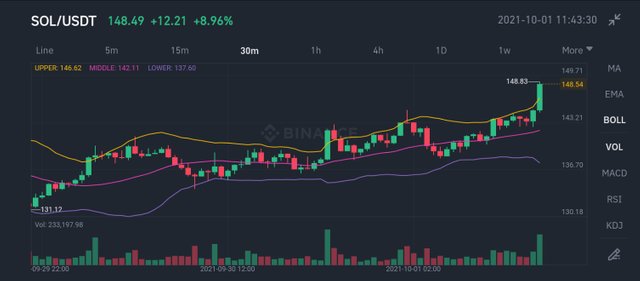
Screenshot from Binance
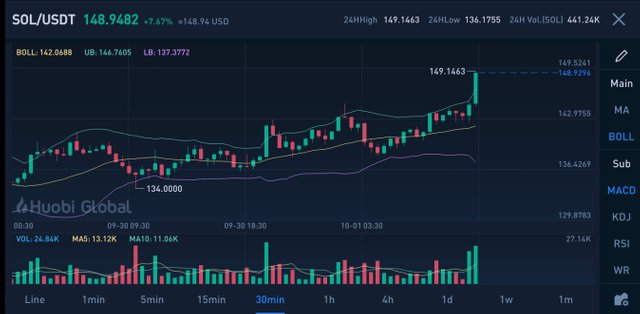
Screenshot from Huobi
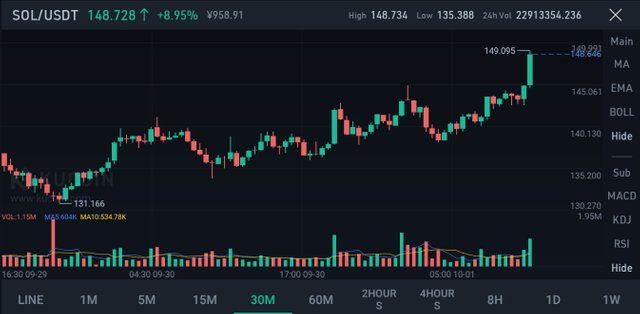
Screenshot from KuCoin
Question 4.- When did Solana Blockchain see its operations interrupted? Why? Explain.
The Solana Blockchain saw its operations interrupted on the 14th of September 2021 as a result of too many transactions that trooped in into the blockchain. As a result of its scalability and transactions fee that favours its users, many transactions were done that shortdown its network and had it's operations interrupted. Nevertheless, it came back to operation on the next day, 15th of September 2021 and today its running smoothly.
Question 5.- Check the last block generated in Solana and make an approximate calculation of How many blocks per second have been generated in Solana, taking into account from the initial block to the current one? Justify your answer and show screenshots.
As at the time I visited (Solana Block Explorer](solana.com), the last block generated in Solana was 99246591
Current block
The block that was generated before the one I saw was 99246592.
Initial block
I have read about the Solana Blockchain that it takes only 0.5seconds to produce a block. This is why it is very scalable. To know the number of blocks that have been generated in Solana I will go into some mathematical calculations.
To know the number of seconds that were used in the production of 99246591 blocks, I multiplied the number of blocky 0.5. This is because it takes 0.5seconds to produce a block.
99246591 × 0.5 = 49623295.5 seconds.
The result means that it took 49623295.5secs to produce 99246591 blocks.
Since Solana has existed for more than a year, we have to convert the value from seconds to year.
To Minutes: 49623295.5 ÷ 60 = 827054.925
To Hours: 827054.925 ÷ 60 = 13784.24875
To Days: 13784.24875 ÷ 25 = 574.34369792
To years: 574.34369792 ÷ 365 = 1.5735443779
Therefore it took 1.5years to have 99246591 blocks of Solana produced.
2blocks is produced in 1second
120blocks is produced in 1minute.
7200blocks is produced in 1hour
172800 blocks are produced in 1day.
63072000blocks are produced in 1year.
Now that we have gotten the number of blocks produced in a year, we can get the number of blocks produced in 1.5years.
Since 1.5 is 1 year and six months, we can divide the value of a block produced in 1 year by 2 and add the result to the total number of blocks produced in a year.
Therefore we have (63072000 ÷ 2) + 63072000 = 94608000blocks.
This means that as at the time of me solving this question 94608000blocks have been produced in Solana Blockchain from the day the first block was produced.
Comparing my answer of 94608000
to the current block of 99246591
I used for my calculations, there is a wide gap gap. This means that the Solana Blockchain produces a block in even less than 0.5. From what I observed when I logged in to Solana’s explorer, it takes about 2 seconds for a block to be produced.
Conclusion
In the ṣecond week of September, my brother drew my attention to the Solana token. He bought it and at that time the coins went down then later came up. He made huge amount of money from it. I didn't take my time to study the coin. Today I know that the continuous surge in its price is as a result of the smooth blockchain on which it is built.
I have successfully completed the homework task of this week. I have a learnt a lot trying to see that I complete the task but I must say, it was tasking. There are so many things to be learnt on this blockchain, I look forward to learning them better.
.jpeg)
.jpeg)
.png)

